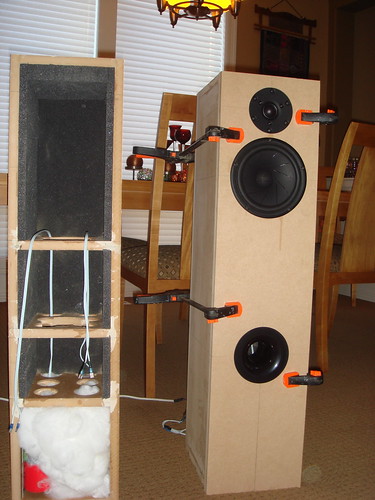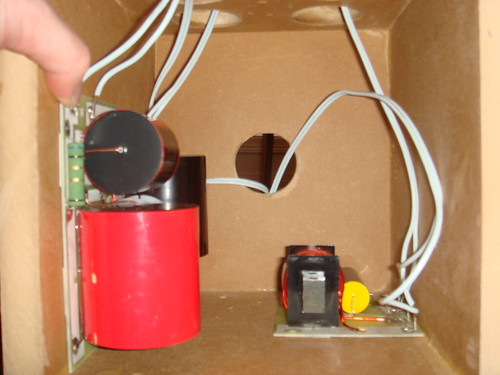djn04 said:My other option is to cut out part of the brace but I don't know what I can get into that tight space that will cut the MDF?
If there's material in the center of the area you want to cut, you could use a large holesaw to cut some away - but it's a bit dangerous if you've got no 'meat' for the center drill to go in to.
A reciprocating saw (powered) would allow you to get into a small space, otherwise a Japanese pullsaw, or maybe even a drywall saw would do the job (with a lot of hard work).
BTW I too noticed you had a treble the wrong way up. Surely you can just flip it over if the screw holes are symmetric? Otherwise, drilling some new holes (and filling the old ones) would be fine, as long as they're not too close to the current holes.
sploo said:
BTW I too noticed you had a treble the wrong way up. Surely you can just flip it over if the screw holes are symmetric? Otherwise, drilling some new holes (and filling the old ones) would be fine, as long as they're not too close to the current holes.
The holes are symmetric but I would have to drill new "ears" for the terminals. I may give it a go though.
I'm gonna try to get a hole saw in there to make the braces larger.
Well it was nothing a 4 inch hole saw and a foot long extension couldn't fix. So now I don't have to hack up the port flare and I there is plenty of air flow in the cabinet.
here are some more pics.

Is there any problem with the placement of the crossovers

Also the design calls for heavy stuff of the bottom of the cabinet. How will I know if I have enough?
Thanks
here are some more pics.

Is there any problem with the placement of the crossovers

Also the design calls for heavy stuff of the bottom of the cabinet. How will I know if I have enough?
Thanks
Pics are looking great.
Cutting a new 'ear' for the treble terminals should be easy with a jigsaw, or even a handsaw (just hack away, albeit carefully).
Can't answer for sure about the crossover placement, as I don't know if something (like a driver magnet) is going to foul it, but generally, as long as it's securely fixed, it should be OK.
Cutting a new 'ear' for the treble terminals should be easy with a jigsaw, or even a handsaw (just hack away, albeit carefully).
Can't answer for sure about the crossover placement, as I don't know if something (like a driver magnet) is going to foul it, but generally, as long as it's securely fixed, it should be OK.
Crossover placement is fine, no worries. As for the stuffing, look to Zaph's site, as I think he shows a diagram or picture. Heavy stuffing at the bottom generally means loosely filled, but completely. In other words, don't stuff it so that the fill is being heavily compacted, but don't let there be visible space either. I recommend a loose amount of fill in every chamber, with it getting progressively heavier and more densely packed toward the bottom.
I would recommend adding a roundover to all upper face edges. In other words, get say a 1/2" roundover bit for your router, and round over the top front edge and front side edges. It isn't just for looks, it reduces diffraction. Given that the wood is 3/4", you could use a roundover of that size, and that would be even better, but that often means that you must have a half inch chuck, which many people do not have.
One last recommendation. Adding fill to the port tube itself (loosely), can add dampening to it's response, as well as absorb higher frequency noise emanating from it. It also has the effect of slowing the air as it travels into the room, and thus can further reduce chuffing. It will change the response however, as doing this begins to restrict airflow out the port, and change the response shape from a true 4th order response to something closer to a quasi-3rd order. In my opinion, this is a good thing. If you like the response with an unstuffed port, then leave it as is, but you may find that stuffing the port a little (experiment with different amounts) "tightens" the bass response. It will slightly reduce the amount of bass the port adds, while also slightly extending the response. The ideal material to use is actually not stuffing but poly filter media with 30 ppm, basically the same stuff Dr. Geddes uses in his horns. It can be ordered in thicknesses up to like 2" I believe before the price gets too high. I bought a roll of 1" meterial and just cut plugs the size of the port, and layer them to the desired level.
I would recommend adding a roundover to all upper face edges. In other words, get say a 1/2" roundover bit for your router, and round over the top front edge and front side edges. It isn't just for looks, it reduces diffraction. Given that the wood is 3/4", you could use a roundover of that size, and that would be even better, but that often means that you must have a half inch chuck, which many people do not have.
One last recommendation. Adding fill to the port tube itself (loosely), can add dampening to it's response, as well as absorb higher frequency noise emanating from it. It also has the effect of slowing the air as it travels into the room, and thus can further reduce chuffing. It will change the response however, as doing this begins to restrict airflow out the port, and change the response shape from a true 4th order response to something closer to a quasi-3rd order. In my opinion, this is a good thing. If you like the response with an unstuffed port, then leave it as is, but you may find that stuffing the port a little (experiment with different amounts) "tightens" the bass response. It will slightly reduce the amount of bass the port adds, while also slightly extending the response. The ideal material to use is actually not stuffing but poly filter media with 30 ppm, basically the same stuff Dr. Geddes uses in his horns. It can be ordered in thicknesses up to like 2" I believe before the price gets too high. I bought a roll of 1" meterial and just cut plugs the size of the port, and layer them to the desired level.
My router will accept a 1/2 inch shank and I'm planning use a 3/4 inch roundover bit. Also the baffles are slightly larger than the cabinets so after I glue them up I'll use a flush trim bit to knock off the excess.
I'll look into the port dampening when they're finished also.
Thanks for the suggestions
I'll look into the port dampening when they're finished also.
Thanks for the suggestions
- Status
- This old topic is closed. If you want to reopen this topic, contact a moderator using the "Report Post" button.
- Home
- Loudspeakers
- Multi-Way
- Newbie looking for advice and encouragement